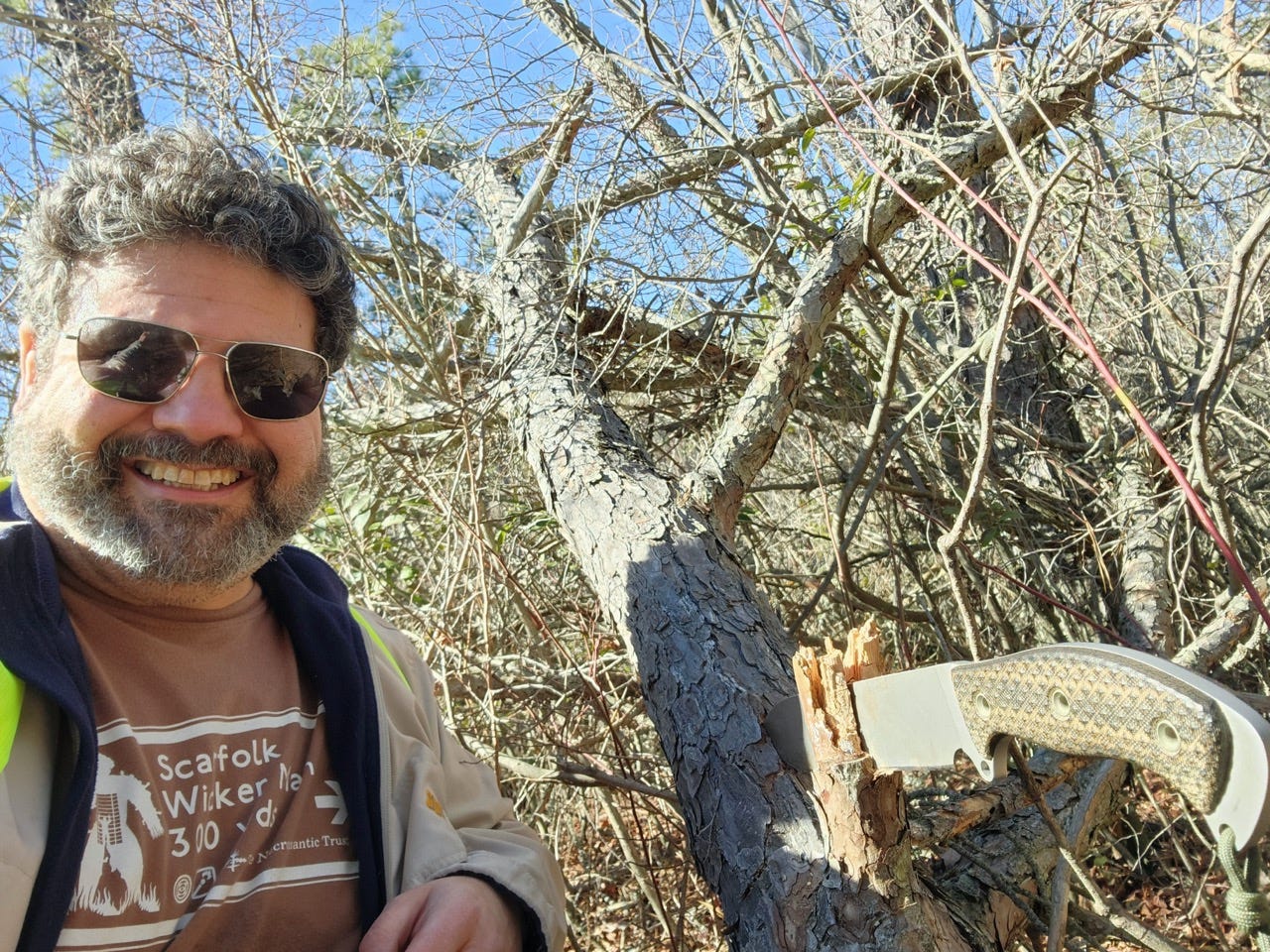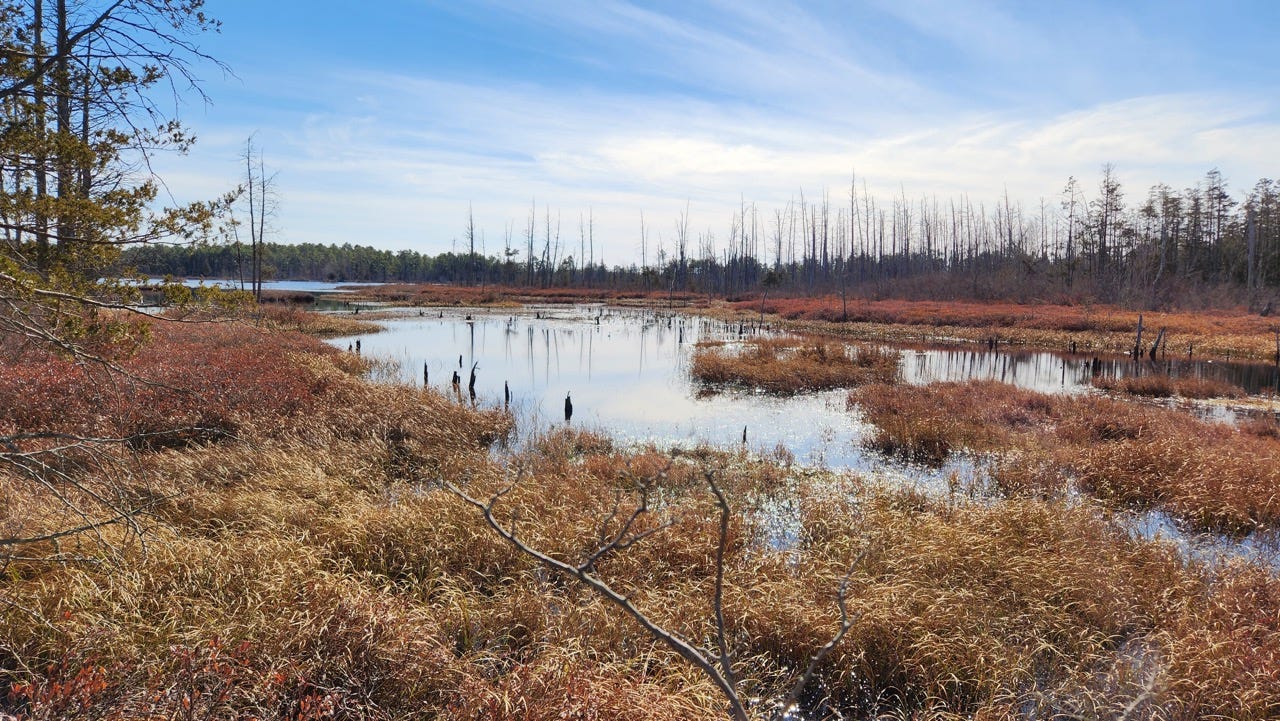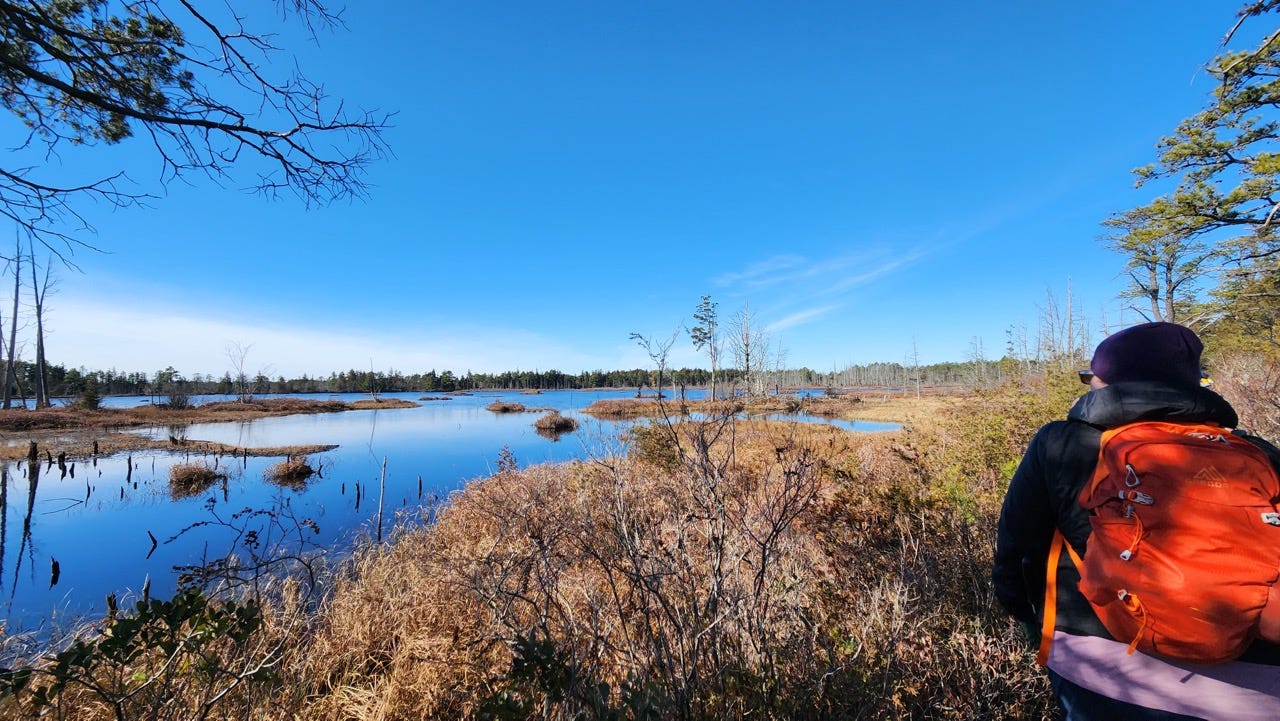If you’ve ever hiked a trail, you’ve probably wondered how it got there. Some were originally trod by animals and adapted by humans, and are thousands of years old; others follow access roads used by firefighters, loggers, or pipeline workers. Most hiking trails in the United States were cut and blazed in modern times.
And they are a lot of work.
I joined a crew of volunteers gathered by the New Jersey Department of Environmental Protection a few weeks ago, to help reroute the Tulpehocken trail that runs down a dirt road from the Emilio Carranza Memorial (you can read more about him in my post at the link) to the ruins of the former cranberry bog town of Friendship (ditto). Friendship is not all that old, and we met with living family of the people who owned the operation, who still tend to the land after it became part of Wharton State Forest. The forest began as a land scam worthy of Montgomery Burns of The Simpsons; a rich mastermind named Joseph Wharton bought 100,000 acres of abandoned properties and planned to dam the waterways and redirect them towards Philadelphia, until the New Jersey legislature caught on and put the kibosh on it.
Now it’s part of the Pinelands Preserve, in thanks partly to John McPhee’s The Pine Barrens, which began as a series of newspaper articles defending the beautiful wilderness of the area, when a supersonic jetport was planned. We’re still fighting to protect it from gas pipelines; it provides trillions of gallons of clean water from its aquifer. The sugar sand behaves like an enormous sponge, soaking up rain and often squeezing it out at inopportune moments like today, when I had to cancel an exploratory trip after two roads were closed by police due to flooding.
On the weekend we began our trail work, it had been dry for a while so the roads were clear. So clear in fact that after cutting brush for a few hours, I took my Subaru down Hawkins Bridge road to Washington Turnpike, a route I have been unable to travel for the past year due to deep washouts that never seem to recede. I saw the bottom of a few of them this time, and the deep ruts cut by 4x4 vehicles were impressive.
But how do you cut a trail? Well, you literally cut it with a pair of loppers or hedge clippers, and then rake the fallen branches off to the sides. We followed a trail I’d call a goat track or deer trail off the main road, across a gorgeous former cranberry bog on the Tulpehocken creek, to where the trail would connect to an existing one a mile north of us. We passed a beaver skeleton on our way, and saw their handiwork in the waters of the bog. Beaver dams are impressive, and so is the ferocious work they make of trees with their natural loppers. But if you see an opening in the swamp grass near the water, where a critter may have waddled out, you might also find a lump of mud there that might seem natural. And it is, but it was created by a beaver, with their handy paws and tail, and marked with their castor sacs to signify their territory.
Castor sacs are like anal glands, but aren’t. They are harvested to this day as a base for perfumes, similar to ambergris; castoreum is said to have a “leather note,” and if you’ve dabbed Shalimar behind your ears, you’ve been beavered. I’ve seen these little lumps of mud many times while hiking in the Pines, and now I know them to be beaver property markers.
These are the things you talk about with nature lovers when you’re stuck together on a goat track choked with catbrier, so called because its thorns scratch like a cat. It was slow going in the beginning, without direction. I had to put on my project manager vest, and kindly suggest that the detail-oriented oldsters allow the raring-to-go young couple to forge ahead and attack the thicket, while me and a strong woman widened the trail left in their wake. Then we cut through the saplings and thorns like a bunch of angry beavers.

Speaking of beavers, their natural predators are in short supply in the Pine Barrens. So much so that the state employs “Beaver Deceivers,” which are not sex toys, but artificial dams that trick beavers into not damming in certain areas. Otters, coyotes, foxes, bobcats, and great horned owls like to eat beaver, and so do humans, but the trapping culture has waned. I’m not a fan of trapping, and I hope the influx of coyotes does the job on beavers, because between the beavers and the overgrown deer herds, trees can have a tough time surviving. The deer eat the shoots and saplings to the nub, and beavers buzz through the adolescent trees.
We humans sure have messed up ecosystems. There is still a strong trapping culture in the Pines, and in Lower Alloway Creek, they hold an annual muskrat fry. I’m normally down with noshing on sustainably harvested game, but one look at that plate and my vegan side took hold. When I was a kid, I learned to bow hunt deer, but never bagged one. I would eat venison that other hunters shared, and I’ve considered hunting if only to help with the overpopulation of them. But I’d rather be hiking or biking in the woods than sitting in a blind or tree stand, waiting for deer to walk by. And if we let the coyotes do their thing, that might be enough.
I don’t even like fishing, anymore. I used to fish often, finding hidden suburban ponds and lakes with difficult access. While it was exciting to pull a fat perch or snake pickerel from these under-fished spots, most freshwater fish in New Jersey are safe to eat only in limited amounts, and as far as I’m concerned, that means my amount can be zero. And if I’m not eating the fish, there’s no good reason for me to set a barbed hook in its mouth and yank it out of the water for my pleasure. I’ve caught fluke, walleye, northern pike, large and smallmouth bass, and even a 45” muskie, but nowadays, it bores the hell out of me. I’m about to purchase a kayak and explore the waters that way. And nobody has to die.
I forgot to include this link to WanderFinder’s beaver post!












This is fabulous. Thanks for helping me justify my habit of spacing out while watching clumps of mud. (Sorry, not spacing out! Examining beaver artifacts!). The castor sacs thing is incredible. So weird what we find attractive in terms of smells -- I can almost smell that smell now, and I know why it's sexy even as the idea of it being a beaver's anal glands does, somehow, take away from the mystique.
It was non-canon, as the kids say:
"After the introduction there is a sketch, where the family are portrayed as beavers living in a dam with Tim Conway as a skunk and Homer's boss"
https://en.wikipedia.org/wiki/The_Simpsons_Spin-Off_Showcase